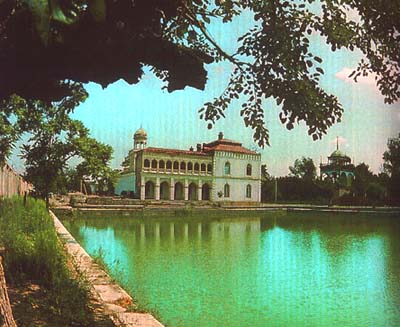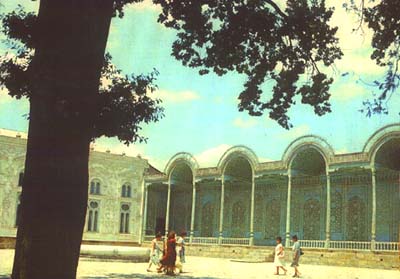Like Louis XVI hunting boar in the grounds of Versailles
while Paris seethed, Bukhara's  last
emir played out his final months in power in a ridiculous summer palace
north of the city, spying on his bored harem through secret peepholes and
trying to incorporate Russian teapots in Islamic decorative art while the
Red Army tightened its stranglehold on his heritage and people. Sitorai-Mokhi-Khosa,
built mostly in the 19th century but still being added to in 1918, is the
great and only repository of 'Bukhara Kitsch'. Reached from two blocks
east of the Hotel Bokhoro by buses 9 and 13, or, much easier, by taxi,
most of it is open to the public, though part of the grounds now belong
to what was sinisterly known in Soviet parlance as a neurological sanatorium.
last
emir played out his final months in power in a ridiculous summer palace
north of the city, spying on his bored harem through secret peepholes and
trying to incorporate Russian teapots in Islamic decorative art while the
Red Army tightened its stranglehold on his heritage and people. Sitorai-Mokhi-Khosa,
built mostly in the 19th century but still being added to in 1918, is the
great and only repository of 'Bukhara Kitsch'. Reached from two blocks
east of the Hotel Bokhoro by buses 9 and 13, or, much easier, by taxi,
most of it is open to the public, though part of the grounds now belong
to what was sinisterly known in Soviet parlance as a neurological sanatorium.
The main gate is a puny but very garish mockery of every
great pishtak in Bukhara and Samarkand. It leads to a modest courtyard
sacrificed to the hard sell of mass-produced silk dressing gowns, which
in turn leads to Said Alim Khan's palace-within-a-palace round three sides
of a larger yard. Named after him and finished in 1917, this is now a branch
of Bukhara's History Museum. A guide will probably
have attached him or herself to you by now if you did
not arrive with one.
Honored guests were received in the White Hall, which
forms the west side of the yard and was decorated by a master stucco plasterer
called Usto Shirin Muradov whose picture hangs by the entrance and whose
hands were maimed on the khan's orders when his work was done-either for
some trifling error or so he could not reproduce the design for anyone
else. The ornate plasterwork in the hall, like most interior decor in the
palace, originally had a generous garnish of gold leaf which
was taken by the Bolsheviks and replaced with bronze.
The fireplace in the chess room round the corner to the
left is German; the silver boxes and fish are genuine antique Bukharan.
Red and blue banqueting halls follow, the first with red lighting, blue
stained glass and a fine collection of daggers; the second, equally nauseating,
has a mirror which reflects you 40 Times. The ordeal by psychedelic ends
when you reach the emir's chai-khana, more
window than wall, containing his ancestor priceless collection
of Chinese vases.
 A
paved walkway leads from the male playground to the female. So, reputedly,
did a secret tunnel for the exclusive use of the voyeuristic emir. Beside
a large khauz now overlooked by the neurological sanatorium is a two-storey
building, more European than Asian in style, where the emir's begums used
to live. The harem was said to number 400 by 1920, when M. N. Roy, an Indian
member of the Central Asiatic Bureau of the Corn-intern, decreed a mass
divorce and allowed Red Army troops in to take their pick. According to
his own account, quoted by Moorhouse,
A
paved walkway leads from the male playground to the female. So, reputedly,
did a secret tunnel for the exclusive use of the voyeuristic emir. Beside
a large khauz now overlooked by the neurological sanatorium is a two-storey
building, more European than Asian in style, where the emir's begums used
to live. The harem was said to number 400 by 1920, when M. N. Roy, an Indian
member of the Central Asiatic Bureau of the Corn-intern, decreed a mass
divorce and allowed Red Army troops in to take their pick. According to
his own account, quoted by Moorhouse,
'The storming of the harem took place under strict vigilance,
and nothing unpleasant happened. The begums, of course, behaved like scared
rabbits, but the sight of the husky young men scrambling for them must
have made some impression on them. Able-bodied young men seeking their
favor was a New experience to women whose erotic life could naturally not
be satisfied by a senile old man. At the end it was a pleasing sight-the
secluded females happily allowing themselves to be carried away by proud
men.'
In the official guesthouse, discreetly separate from both
palace and harem, there is a collection of royal robes which is outshone
by the one in the Tashkent Museum of Art although the spare room itself
must have rivaled any in the world for sheer extravagance. There were 4.5
kilos of gold on its walls.
[back]

